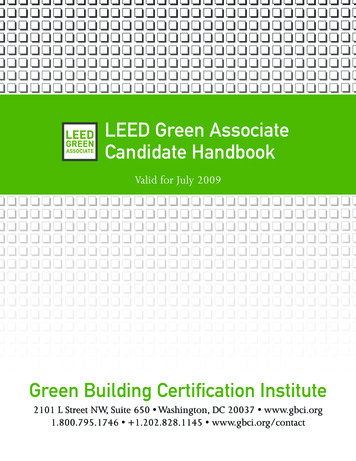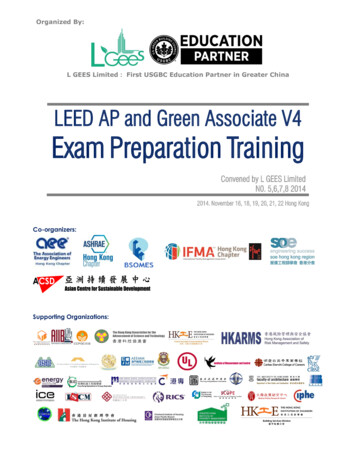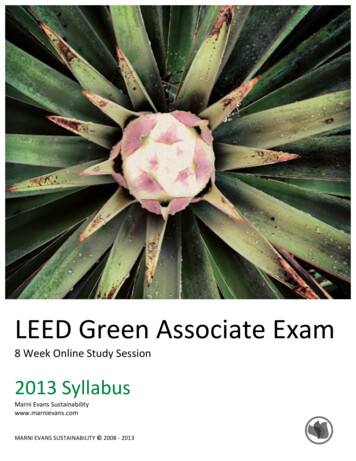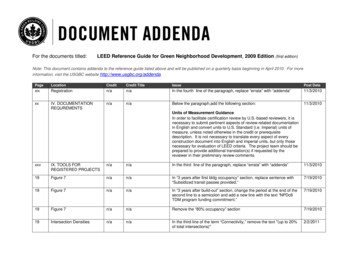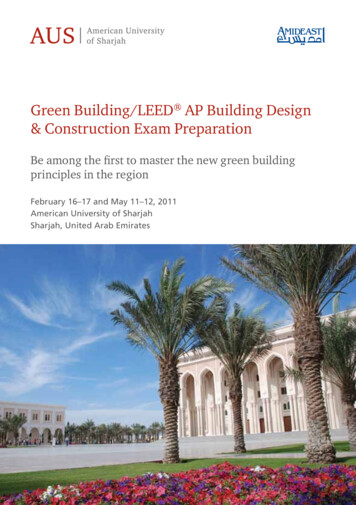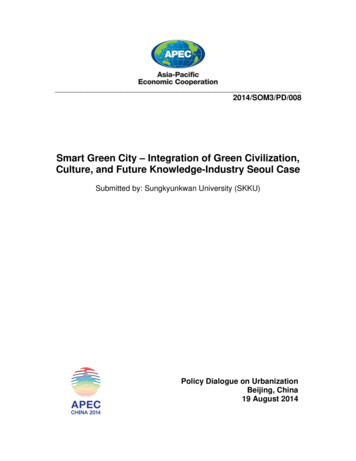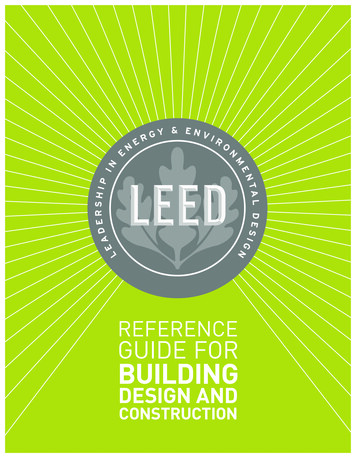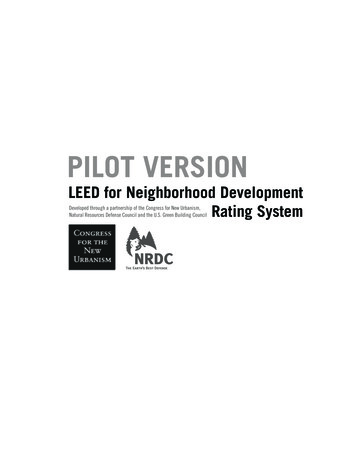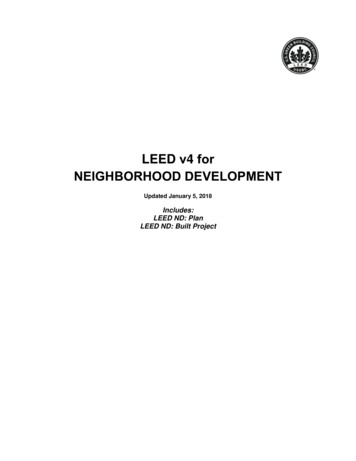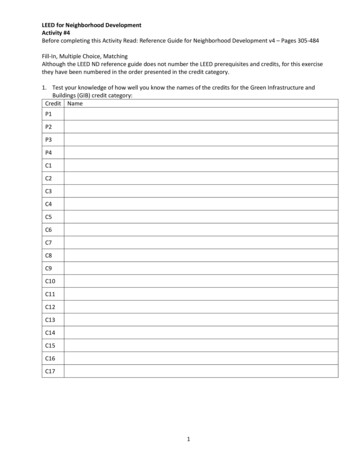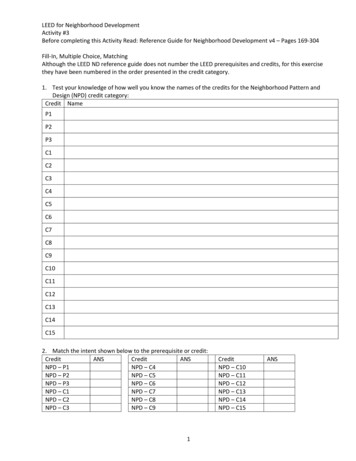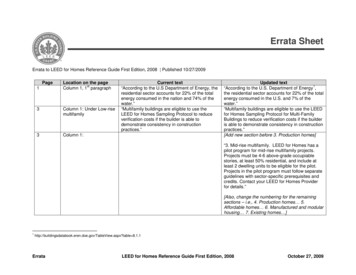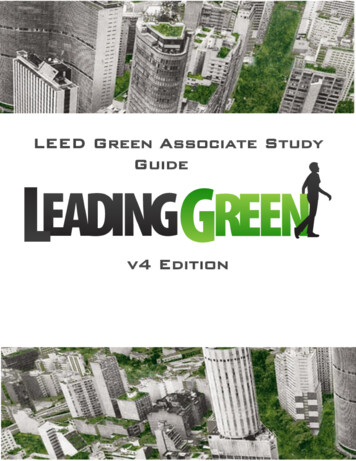
Transcription
LEED Green Associate StudyGuidev4 Edition0
Table of ContentsIntroduction:. 2Green Buildings . 4U.S. Green Building Council (USGBC) . 10LEED for HOMES. 23Integrative Process (IP) . 26Location and Transportation (LT) . 30Sustainable Sites (SS). 37Water Efficiency (WE). 44Energy and Atmosphere (EA) . 50Materials and Resources (MR) . 59Indoor Environmental Quality (EQ). 66Innovation and Design (ID) . 73Regional Priority (RP) . 76Additional Readings . 78LEED Green Associate Exam Tips. 79References . 80Table of Figures . 81Summary of Referenced Standards . 84Impact of HVAC Refrigerants . 851
Introduction:The LEED Green Associate Study Guide:This Guide is an introduction to the basics of green building, a foundation for a more sustainable future and aresource to help you pass the LEED Green Associate exam. It is to be used to reinforce your in-class learningand cement the knowledge in your head. It presents concepts and strategies of green building using bestpractices that are environmentally responsible and resource efficient.The guide is divided into chapters, starting with an overview of Green building and sustainability, theninformation about the USGBC, GBCI, LEED and its evolution andfinally, a review of the seven categories in LEED as follows:1.2.3.4.5.6.7.8.Location and TransportationSustainable SitesWater EfficiencyEnergy and AtmosphereMaterials and ResourcesIndoor Environmental QualityInnovation in DesignRegional PrioritiesFigure 1This guide includes most of the information you need to pass the LEEDGreen Associate exam but it is recommended that you download theLEED Green Associate candidate handbook and the excerpt from:1. Introduction and Overview - LEED BDC V4 Reference Guide - http://leadinggreen.ca/?p 30512. LEED v4 Green Associate Candidate Handbook – Click here to DownloadLEED Discussion:Now and before you get more involved with LEED, are you sure it is really worthwhile?As a professional pursuing a credential it will cost you money and time, as a building owner pursuing acertificate for your building, it will probably raise the initial costs of your project.To know the answer, we need to look at the following facts: since early in the 21st century we have been facingenvironmental crises from global warming, climate change, species extinction, droughts, floods and hurricanes.In addition we are running out of fossil fuels, thus we might not be able to meet our needs in the near future.There is no other choice but to lead a more sustainable lifestyle in all aspects including the built environment(the largest consumer of energy). LEED is a legitimate, marketable green building rating system whichencourages environmental commitment from all stakeholders. Professionals from every sector should be welleducated and equipped with the ‘know how” to face these challenges, and this is exactly what makes LEEDCredential important and worthy. It provides you with the knowledge of the best practices in the industry and itis based on stringent codes and standards. The credential simply certifies that you are qualified for your role.Importance of a LEED Certificate is different from an owner’s perspective, it doesn’t matter how green yourbuilding is unless you can prove it. A LEED Certified building needs no more proof than the certificate. It is athird party verified green building, and that means that you built an efficient building that provides the healthiestenvironment to its users and has a lower impact on the natural environment and resources. Add that to theThank You from your community, building users and generations to come, the owner will earn marketability forhis/her building, possible incentives from the government, more productive employees, and lower operationsand maintenance costs. Owners worry about the higher initial costs of green buildings, but studies prove thatthrough good design and construction they only cost slightly higher or are on par with traditional buildingscosts. Looking at the financial return of a green building and its aforementioned benefits, Green Buildings arenot only environmentally responsible, they are also be more profitable in the short and long term. LEEDcertification is the standard for defining a green building and it is the only respected designation insustainability which is tailored to accrediting industry professionals.2
CHAPTER 1GREEN BUILDINGS3
CHAPTER 2The Governing Bodies of LEED – USGBC GBCI9
U.S. Green Building Council (USGBC)The U.S. Green Building Council (USGBC) is a 501(c) (3) nonprofit organization. It was formed in 1993 andbased in Washington D.C. Members of USGBC include building owners and users; real estate developers;facility managers; architects, designers, engineers, general contractors, subcontractors; product and buildingsystem manufacturers; government agencies and nonprofits. They represent companies and organizationsfrom across the building industry.USGBC’s Mission: "To transform the way buildings and communities are designed, built and operated,enabling an environmentally and socially responsible, healthy and prosperous environment that improves thequality of life."USGBC's Vision - Buildings and communities will regenerate and sustain the health and vitality of all lifewithin a generation.USGBC is a Voluntary, Market driven and Consensus based organization that provides: Educational opportunities for both public and industry professionals through workshops and online orlive seminars. USGBC helps industry professionals pursue accreditation as LEED professionals fromthe Green Business Certification Inc. (GBCI). Green building resources, strategies and tools for project teams and organizations interested inexecuting green buildings. Networking through forums to support green building dialogue and communication. Tracks the status of all LEED professionals including Green Associates and AP .There are only 2 formally acceptable ways to refer to the USGBC:1. U.S. Green Building Council2. USGBCIn 2002, USGBC launched Green Build the world's largest green buildingconference.Green Business Certification Inc. (GBCI)The Green Business Certification Inc. (GBCI) is a separate entity that manages LEED professionalaccreditation program and the LEED project certification process. The GBCI was established in 2008 with thesupport of the U.S. Green Building Council and administered LEED project certification through third partycertification bodies accredited by the American National Standards Institute (ANSI). GBCI complies with ISOstandard 17024.GBCI responsibilities: GBCI manages the LEED professional accreditation program that includesexamination development, registration and delivery.GBCI manages the development and implementation credential maintenanceprogram (CMP), it determines the continuing education requirements for LEEDaccredited professionals.GBCI administers the LEED project certification process, evaluates a project’sapplication and provides certification10
EligibilityA project that meets all the required MPRs and prerequisites and can achieve the minimum number of pointsto earn a certification level is a candidate for LEED certification.Project Checklist (LEED Credit Scorecard)It is a form provided by the USGBC that includes the prerequisites and credits of the selected rating system.This form is used by the project team (often during a Charrette) to determine if they can meet all theprerequisites and the certification level they can achieve.Figure 11The 3 phases of credit applications:1. Predesign – Discovery2. Schematic Design – Design and Construction3. Feedback Mechanisms – Operations and performance monitoring19
Credit Forms and CalculatorsCredit forms are used to document and verify credit/prerequisite compliance. Credit forms ortemplates are Adobe interactive PDF forms accessible by Project Administrator and project teammembers via LEED online. Each credit/prerequisite has its form which lists the documentationrequirements for its achievement and signed by a specified team member. Calculators are built in forthe credits that need calculations.Samples of Credit Templates and Forms are available on the USGBC website nline-formsApplication Process OutlineInitiate Discovery Phase – Follow steps in the Integrative Process CreditSelect a Rating System – Use the 40/60 rule to pick the appropriate LEED Rating systemCheck MPR complianceEstablish Project Goals - align with the project’s context and the values of the project team,owner, or organization. This is accomplished through a goal-setting workshop (see IP)5. Define project scope – map the LEED Project boundary and explore any special certificationprograms such as Volume or Campus applications6. Develop LEED scorecard (see above) – Select Y/?/N for each credit based on expectations7. Continue Discovery Phase – additional cost and strategy analysis8. Continue Iterative Process – repeat the 7 steps above until satisfaction9. Assign Roles and Responsibilities – One team member leads the process and manages theapplication and documentation10. Consistent Documentation – gather data at regular intervals to ensure ongoing progress11. Quality Assurance – review all LEED documentation to avoid errors prior to submission1.2.3.4.Certification Process - There are two options: Split Review: some of the project credits/prerequisites can be submitted during the design phase asoutlined in the LEED reference guide. Other credits/prerequisites must be submitted duringconstruction phase. Only after the construction process can these points be earned.Combined Review: all credits and prerequisites are submitted for review at one time. The project teamcan choose the option that best suits their project case. Only available for LEED BD C and ID C.Review ProcessPreliminary Review – After this process the project administrator will receive a preliminary rating and requestsfor additional information per credit. The project administrator has the option to appeal the reviewer’s decision.Final Review – Any new information is reviewed and a final rating is received by the Project administrator. Theproject administrator has the option to appeal the reviewer’s decision, but once the decision is accepted nofurther appeals may be made. The project cannot reapply for LEED certification if it is denied.Once certification is accepted the project will be included in the LEED Project Directory and a plaquewill be received based on points achieved.20
Project Credit Interpretation Requests/Rulings (CIRs)If a project team needs any clarification regarding any credit or prerequisite then they may send a creditinterpretation request at a cost of 220 for each request. Credit interpretation requests can be submitted by theproject team at any time after the project registration. CIR requests must not exceed 600 words or 5000characters including spaces. No attachments, cut sheets or drawings are allowed within a CIR request exceptfor LEED ND where a site plan can be attached.Credit interpretation rulings are the reviewers’ responses to these requests, credit interpretation rulingsconstitute precedents. If a project team encounters unclear issues they sho
for LEED ND where a site plan can be attached. Credit interpretation rulings are the reviewers’ responses to these requests, credit interpretation rulings constitute precedents. If a project team encounters unclear issues they should: - search the reference guide for help -
